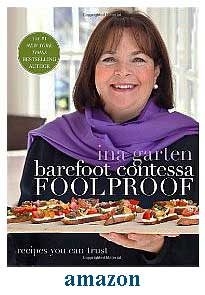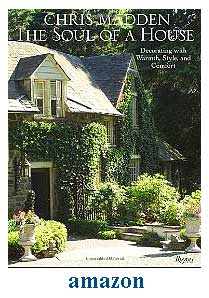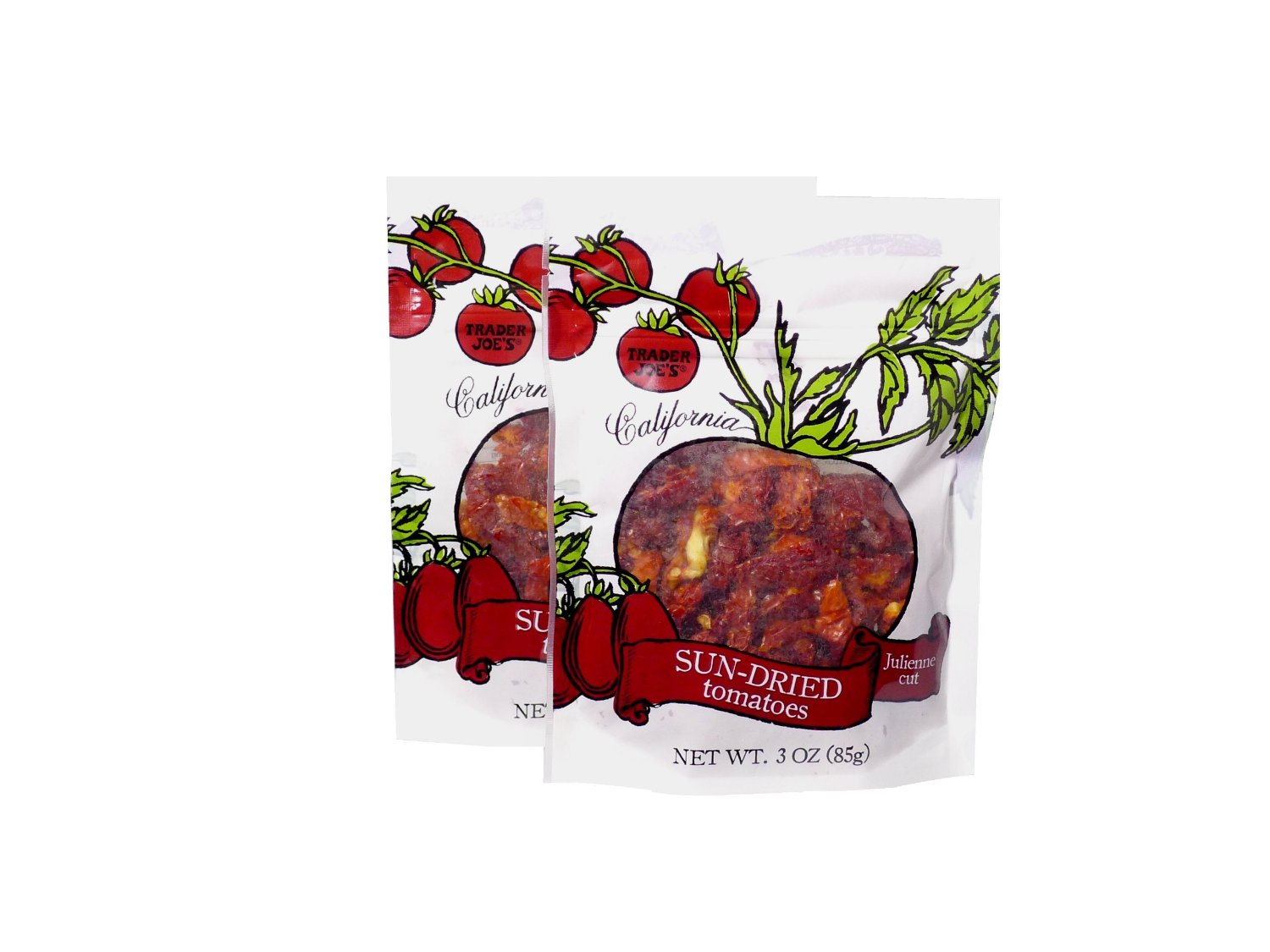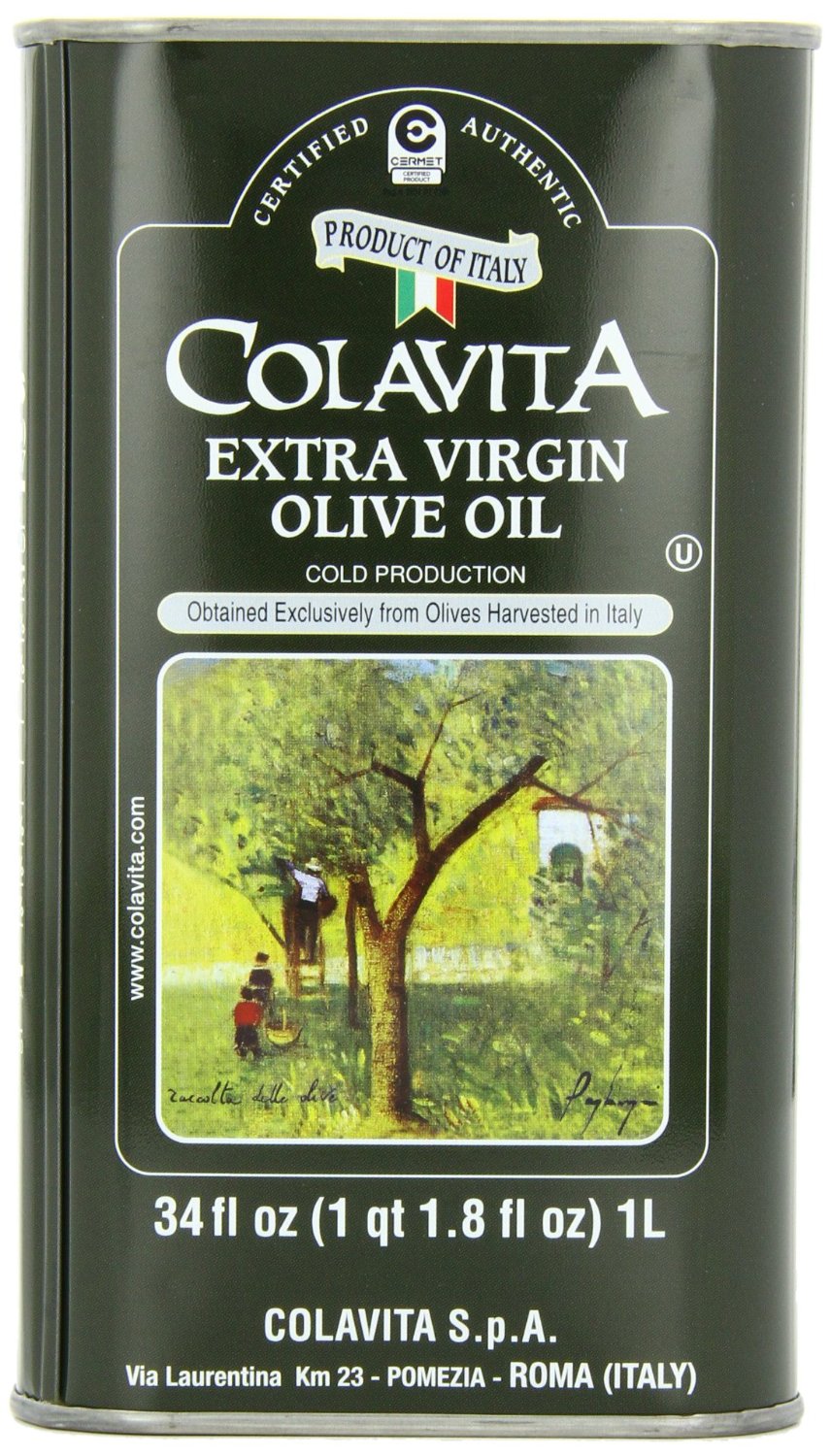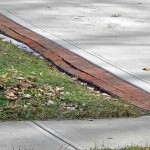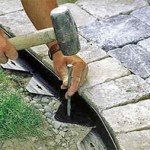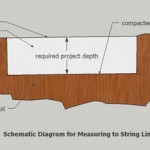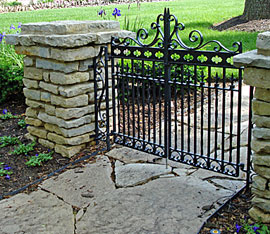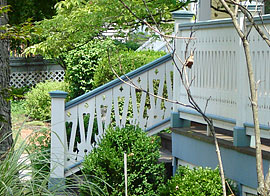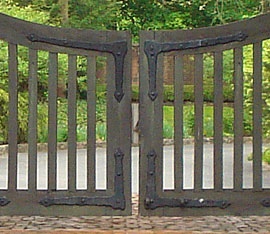While there are a number of different Victorian house styles (Shingle, Second Empire, Richardson Romanesque, and Stick), the Queen Anne was, and is, the most popular. We have to stop here to say that there is so much to talk about when it comes to this style! So brace yourself! Grab a cup of coffee and enjoy! If you do additional research, you will find even more.

Notice the decorative cutout patterns in the panels of the porch railing
Typically, we think of the Queen Anne as a large house with a big wrapped porch, an intricate roof plan, 2- or even 3-stories tall, and sometimes, with a turret (tower-like) thrown in for good measure. But the Queen Anne style runs the full gamut in sizes and detailing – from what we just described, to the modest 1-story cottage, known as a Folk Victorian.
Today, the Queen Anne is perhaps the most familiar of all the Victorian styles due to its easily identifiable characteristic features, such as a wrapped porch, the architectural ornamental detailing, special siding designs (fish scale, patterned woodworking) in the gables, and speaking of the gables – all that beautiful detailed woodworking at the peak of the gable’s ridge.
Bit o’ History
It helps to understand what was happening historically and how these events helped produced the ‘look’ of the Victorian style. The Victorian era appeared on the scene during the time of the Industrial Revolution. With the help of this industrialist period, house construction became a whole new ball game.
Lumber mills could cut lumber, not only in standardized sizes, but it could be cut quicker, cheaper, and in longer lengths. Also, factories were mass-producing construction nails at lightning speed. These newly rising industries (which also made houses more affordable), and other technologies, like the use of the balloon framing method to build houses, lead to the break from of the square and rectangular floor plans (ie. Georgian, Federal, Dutch Colonial) of the preceding period house styles. It was now possible to create intricate floor plans (lots of corners and interesting roof plans!).
Today, many homeowners of the original Queen Anne Victorians (circa 1880-1910) restore them with period materials to retain the authenticity of the style. Our brother and sister-in-law are in the midst of restoring their Queen Anne. Luckily, there are manufacturers who make reproduction hardware, lighting, windows, paint colors, and more, not just for Victorians, but for all period styles. There are even sites that sell reclaimed Victorian hardware.
While we have focused a bit on the Queen Anne style, we include all Victorian styles in our suggestions for your yard. This period had so much going on (more than we could include here) due to all the new innovations taking place. And added to the mix, you could say the suburban yard was being born. Families were now looking to the countryside to live, leaving the crowded city behind. Yes, the new suburban way of living was taking hold.
Yard and Outdoor Improvements
If you want to add to the authenticity of your Victorian yard and house, no matter how modest or grand they may be, and to whatever capacity or degree, some suggestions to help and inspire are:

Lighting:
• traditional fixtures are of various types – some period fixtures were heavy, but there were fixtures that were made lighter in appearance by using less metal framing and more glass; styles: wall sconces with scrolled arms are very traditional, also, pendants, chandeliers; today reproduction light fixtures are created from various metals, like brass and cast aluminum with antique, aged, polished, patina, and black finishes for vintage looks
• traditional features also include glass types of amber glass, frosted, white, fluted, etched, and seeded
• beautifully detailed wood lamp posts using Victorian motifs can add charm to your outdoor spaces (see Photo featuring light fixtures)
Mailbox and House Address:
• mailbox (or letterbox as it was called back then): metal or wood turned post with ornamental finial; metal house-mounted and the built-into-the-wall styles in a traditional style including the use of ornamental scrolls and, vine motifs
• address: choose numerals with a traditional Victorian typeface (font); these also were highly decorative – examples are easily found on the web
• traditional placement for numerals on an architectural feature, like a porch or mailbox post, a mailbox arm bracket, engraved on a stone plaque wall inset, and a wall-mounted plaque with scrollwork near the entry door
• colors for the metal elements included black, verde green, bronze, and gray
Hardware:
• Victorian hardware will likely have some degree of ornamental design ranging from highly decorative to rather reserved designs
• traditional hardware was made from forged cast iron, yellow brass, and polished brass (the brass would age to have a patina); today, all of these metals are still available, plus cast aluminum, aged brass and copper, and oil-rubbed bronze; buy the forged iron and cast aluminum with a powder coating to resist rust, and the brass and copper elements with a lacquered finish to prevent tarnishing (although many times intricate detailing gets a beautiful patina when not lacquered)

Beautiful reproduction Victorian door bell
• traditional outdoor hardware includes the strap hinge, Suffolk latch, stable door latch, tee hinges, shutter dogs, shutter hinges (see Photo of gate strap hinge)
• also for your Victorian, include traditional hardware styles and finishes for your entry doors, garage doors (or carriage doors), doorknockers, door bells, and gates
• you can get reproduction hardware that is powder coated to resist rust; brass can have a finish to protect it from an aged or patina look, or you can get it without that finish if you like the patina look; there are so many finishes to appeal to varying tastes!
• there are various websites that sell reclaimed hardware from the original Victorian period in England (search: Victorian ironmonger)
Pavement:
• for driveways: carriages were the mode of transportation in the early period; in the mid 1890’s cars started slowly being used and they were really like open carriages without the horses; the brick paver was a traditional material, and with the automobile not in the mainstream yet, it seems like the average homeowner may have used loose materials like clay or limestone chips for the driveway
• for walks, and outdoor gathering areas: flagstone was very popular, and brick pavers
Structures:
• fences were very popular – many new homeowners enjoyed showing everyone where their property line was (in an aesthetic way!)
• foundries had the ability to create cast iron fences with much ornamentation; all ornamentation was not gingerbread-y; much design was very stately looking

Victorian gate hardware; ornamental shapes for the pickets
• wood fences: the pointed top of the colonial picket was replaced with more ornamental shapes (cut-outs, scalloping), and round pickets with turned tops for more detail; prominent fence posts with sphere, urn, and beehive finials are examples of details used at the gateway and on railing posts
• walled gardens were created by tall brick walls; because of the expense, usually only gardens of the wealthy had them; the English Garden Wall Bond was a popular brickwork bond design of this era
• other popular structures were the garden shed (these can be mimicked after the house architecture or even a carriage house of the day); arbor (one way to use an arbor can be as a ‘door’ connecting areas of different use), trellis, gazeboes
• a trellis or lattice panel attached to one end of a porch with a climbing vine would provide privacy
• railings included the use of balustrades, a chippendale pattern, and, on houses that had a more gingerbread-look, wood panels of seemingly endless designs were used instead of balustrades, such as wide boards with decorative cutout patterns, and patterns that resembled lace (all this intricate design courtesy of industrial-age technology!)
Color Palettes:
(we thought the Victorian style deserved its own paint color section)
• the concept of a color ‘palette’ had to have been made popular with all the many colors traditionally used to paint a Victorian house
• typically, a house of this era uses 3, 4, 5, and more hues to create the look (some of the colors of the palette are used sparingly for perhaps highlighting a repeating detail); and when tastefully done these palettes are beautiful

Notice the pattern woodworking of the gables; great color palette!
• color palettes are typically subdued, yet can be quite striking
• selecting your own colors can be an exciting part of owning a Victorian; yet if your house is on a historic registry you may be limited to a specific color palette to choose from
• if you need help, work with a color expert who is familiar with Victorians
Outdoor Furniture:
• traditional elements included tables (dining, side), chairs (dining, leisure), benches (with or without backrest) made of wood, wrought iron (this material requires more maintenance to keep it from rusting), porch swings, and wicker (very popular)
• today furniture materials like forged iron and cast aluminum are powder coated to prevent rust (you can actually buy cast aluminum products that look like wrought iron – Yay for technology!); it is very easy to find traditional looking Victorian outdoor furniture and accents in a classic look with these new materials, and this applies to weather resistant materials that resemble the natural beauty of wicker
Plants:
• with the rise of suburban life, the lawn became an important part of the Victorian outdoors, working as a unifying element to emphasize the gardens; the lawns of this era eventually became the place to play lawn games including croquet; lawn tennis was a popular game of middle-class Victorian women (running in all those layers of clothing had to be a sport in itself!)
• popular plants of this period included – rhododendron, azalea, boxwood, hollies, hydrangea ((Snowball), roses (shrubs and climbers), lilac, peonies, Boston ivy, Virginia creeper, spirea (Vanhoutte), mock orange, viburnum (Snowball Bush), clematis, kitchen gardens
• cutting gardens included China asters, sweet pea, zinnias, hollyhocks, larkspur, dianthus; other flowers and greenery included – geraniums, coleus, asparagus fern, and floss flower which was very popular
• with each era, plants went in and out of favor, and just as today, new varieties become new favorites – be sure to add your favorites, too!
Accents:
• planter boxes and planter stands (wood or metal), lamp posts, oversized urns, Chinese art objects, bird baths, sundials, fountains, sculpture, and ponds with goldfish (another Chinese influence of the time)
• benches were incorporated into the gardens along paths and were situated to be able to take in a specific view
• use door mats that complement the Victorian style of your house; shop for them in cast iron and faux iron (rubber); these reflect the era use of scroll and ornate ironwork – great entry door feature
• traditional fabrics for porches included textured fabrics such as damask; traditional prints in cotton toile fabric included – floral, pastoral scenes, stripes, and scroll patterns for outdoor cushions and pillows – all in rich, yet subdued hues
• today, we have available so many new types of outdoor fabrics (i.e. Sunbrella) that are not only durable and easy to care for, but come in fabulous prints and colors that would work for this house style
• a fun way to add a vintage look in your garden is to label plants with antique flatware engraved with the name of the plant
Exterior House Improvements:
• there is something for everyone’s taste in the Victorian style whether you like the gingerbread embellishments – spindlework frieze and bracket post corners of the porch, or the quite reserve of the stately Victorian, or somewhere in between; whether you have a modest Victorian style house or a grand one, there are many details and features you can use to enrich the exterior of your house and the yard
• window shutters were raised panel, panels with iconic cutouts, and louver; some had arched tops
• most houses of the day used wood roof shingles made from cedar; slate and tile roofing shingles were used also; today, replacing a slate or tile roof can be very expensive, but there are modern roofing materials, including rubber and engineered-composites, that are manufactured to resemble slate, and other natural roofing materials
• windows – single pane, double-hung; special windows in certain areas of the house included: a bay window, the double-hung with beveled cut glass in the top sash, the use of smaller multi-panes, leaded glass, and Palladian windows
• traditional entry doors are very often wider and many times included a transom above the door, and side lights (small windows along side the door); traditionally entry doors used much glass (including leaded glass, bevel-cut glass) in the design of the door; if you love wooden screen doors you can even find them with vintage Victorian detailing
• patterned masonry chimneys are traditional

This new garage incorporated authentic Victorian features & details to match the house style.
• there are a few types of wall-cladding for the Victorian styles that included brick, wood clapboard (narrower in width, such as a 4” reveal), and wood shingle siding; today, there are siding materials that can be used that resemble the original materials and that are weather resistant; check what materials you can use if your house is on a historic registry
• picking the right color palette for your Victorian is a great way to add to the architectural quality of the house (it can also enhance it’s curb appeal); many paint manufacturers have color palettes to guide you; also, check out the ‘Color Palette’ section above
• as an observation, we’ve noticed that many times older houses fall victim to unfortunate renovations and updates by way of bad material choices, or additions onto the house that are not in scale or in character with the architecture and really do very little to enhance the authenticity of the style
• even modest improvements can add a richer architectural experience for the homeowner
If you are planning an addition or renovation to your Victorian house, we would encourage you to talk with an architect – they can design the new addition or renovation to make sure it is correctly designed and scaled to preserve the architectural integrity of the style. And for period architecture outdoor projects – we would encourage you to talk with a landscape architect for those same reasons. Staying true to the architecture of the house, for any renovation, can add value to your property.
A fun note to end on: for those of you who remember, the house where the character Mary lived in the Mary Tyler Moore Show, was a Queen Anne Victorian. Do you recall the large Palladian window in her apartment?
![]()




